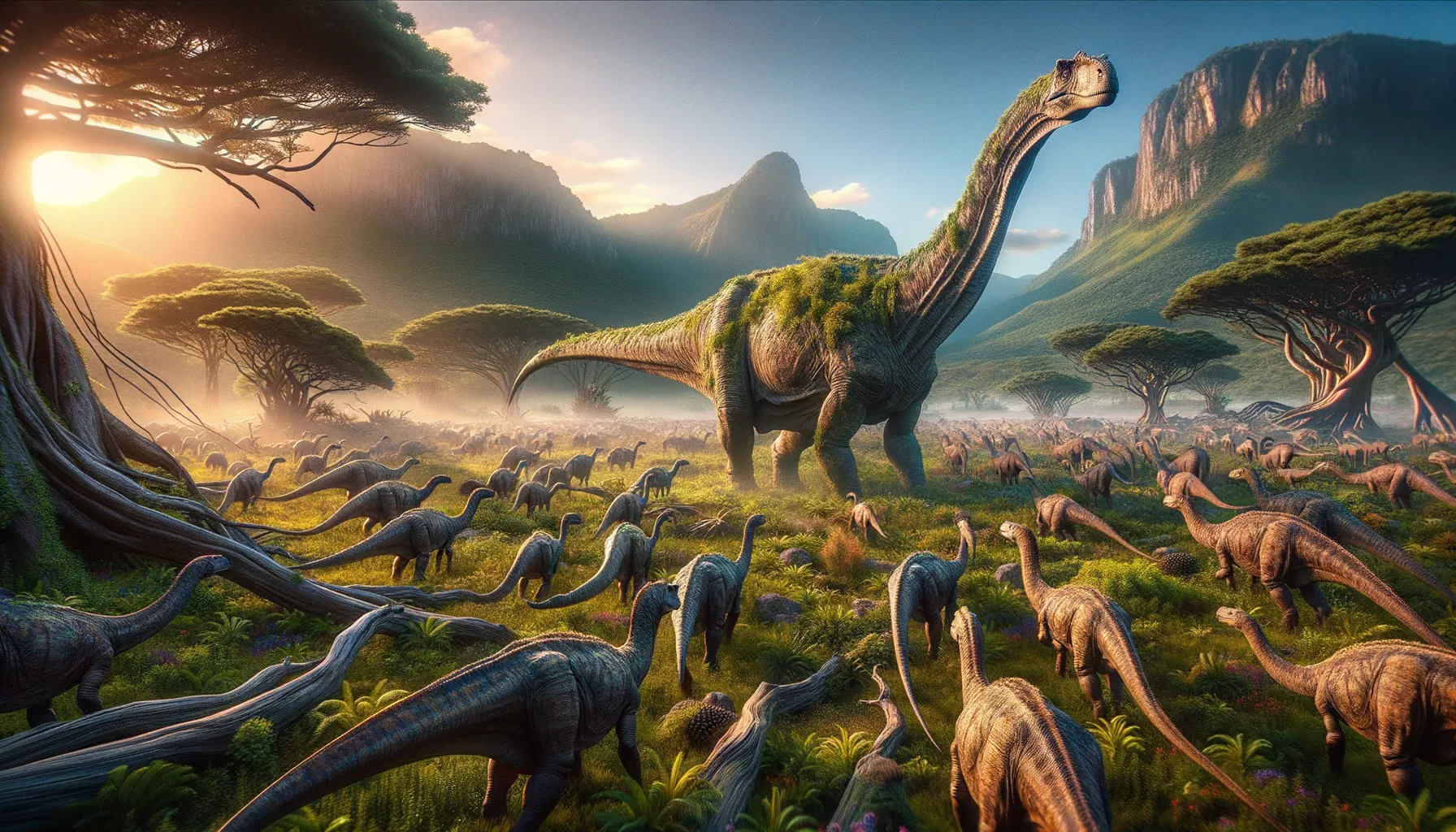
Dinheirosaurus
The gentle giant of the Jurassic age.
Period
Jurassic
Length
Around 25 to 30 meters long.
Height
Approximately 8 meters tall at the back.
Weight
Estimated to weigh around 20 metric tons.
Dinheirosaurus was a massive sauropod dinosaur known for its long neck and enormous size. It roamed the ancient landscapes of present-day Portugal during the Late Jurassic period. As a herbivore, it primarily fed on a variety of vegetation. Like many of its relatives, it likely moved in herds for safety. Its fossils provide important insights into the fauna of Jurassic Europe and help us understand the distribution of sauropods globally.
Diet
Dinheirosaurus was a herbivore, consuming a diet rich in vegetation. It likely fed on a variety of plants, using its long neck to reach high foliage in trees. Its diet would have consisted of ferns, conifers, and other prehistoric plants.
Hunting
As a herbivore, Dinheirosaurus did not hunt. Its primary focus was on foraging for plant material and moving between feeding grounds. It relied on its size for protection against predators rather than active hunting strategies.
Environmental challenges
Dinheirosaurus faced environmental challenges such as finding sufficient food sources to sustain its large size. Seasonal changes may have affected the availability of edible plants, requiring the dinosaur to migrate. Its habitat was likely subject to volcanic activity, presenting further threats. Climate changes during the Late Jurassic could also lead to variations in habitat and food availability.
Speed
Relatively slow-moving due to its massive size.
Lifespan
Likely lived for several decades.
First discovery
Discovered in Portugal in 1999.
Fun Facts
- Dinheirosaurus was a long-necked dinosaur that lived during the Late Jurassic period.
- It belonged to a group of dinosaurs known as sauropods, which were known for their massive size and long necks.
- The remains of Dinheirosaurus were first discovered in Portugal, making it one of the few known dinosaur species from this region.
- Despite its enormous size, Dinheirosaurus was likely a herbivore, feeding on plants and leaves.
- Dinheirosaurus is estimated to have been about 25 meters in length, which is roughly the length of three school buses!
- This dinosaur lived approximately 145 million years ago, sharing its environment with other fascinating dinosaurs.
- The name 'Dinheirosaurus' means 'Dinheiro's lizard,' named after the area near where its fossils were found.
Growth and Development
Dinheirosaurus, like other sauropods, experienced rapid growth during the early stages of life. It hatched from eggs and grew quickly to reduce the risk of predation. Its development included significant size increases, requiring vast amounts of plant material. Growth rates varied throughout its lifespan but were generally fast to ensure it reached a size capable of deterring predators.
Habitat
Dinheirosaurus inhabited areas that were lush with plant life, providing ample food sources. It thrived in environments that supported diverse vegetation including forests and flatlands. This dinosaur likely preferred areas with access to large bodies of water. Its habitat would have been part of a dynamic ecosystem with various other dinosaur species.
Interaction with other species
Dinheirosaurus interacted with other sauropods and diverse species in its ecosystem. It likely coexisted with theropods and smaller herbivores, maintaining a complex food web. Its large size served as a defense mechanism but could also result in competition for resources. Communication within its species might have involved vocalizations or other signals to maintain group cohesion.
Natural lifespan
Dinheirosaurus likely had a natural lifespan of several decades.
Reproduction
Dinheirosaurus reproduced by laying eggs in secure locations. Nesting sites were likely chosen for safety and proximity to food sources for the young. It may have engaged in some form of parental care to ensure the survival of its offspring. Eggs were laid in clutches, increasing the chances of species continuation.
Social behaviour
Dinheirosaurus is believed to have showcased herd behavior for protection. Social structures might have involved complex interactions among group members. Herding minimized the risk of attacks from predators and allowed for shared resource locations. Such behavior also facilitated communication and cohesion within the species.
Fossil locations
Fossils of Dinheirosaurus have been primarily found in Portugal. The remains provide crucial evidence of sauropod distribution in the European continent. These discoveries aid our understanding of the Late Jurassic ecosystem. Excavations in Portugal continue to contribute to paleontological research on sauropods.
